
By:
- April Green
Published Date
By:
- April Green
Share This:
Five Decades, Countless Memories
An architectural masterpiece turns 50
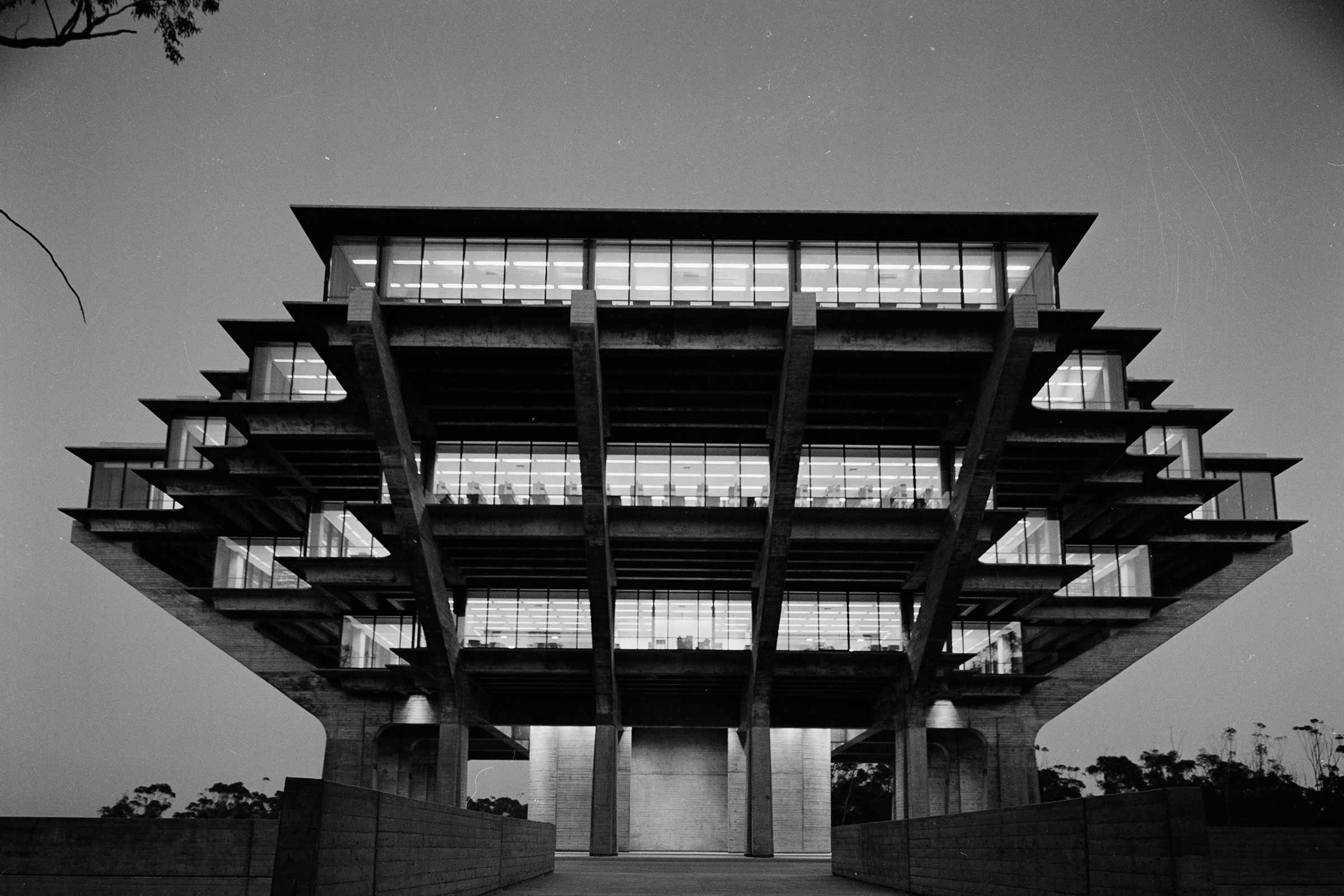
The UC San Diego Central University Library circa October 1970. Photo courtesy of Scripps Institution of Oceanography Photographs, Special Collections & Archives, UC San Diego Library.
Close your eyes and travel back in time to 1970. Place yourself at the University of California San Diego and take a look around. The campus, only being 10 years new, was just opening its third college and had significantly fewer students, faculty and buildings than today.
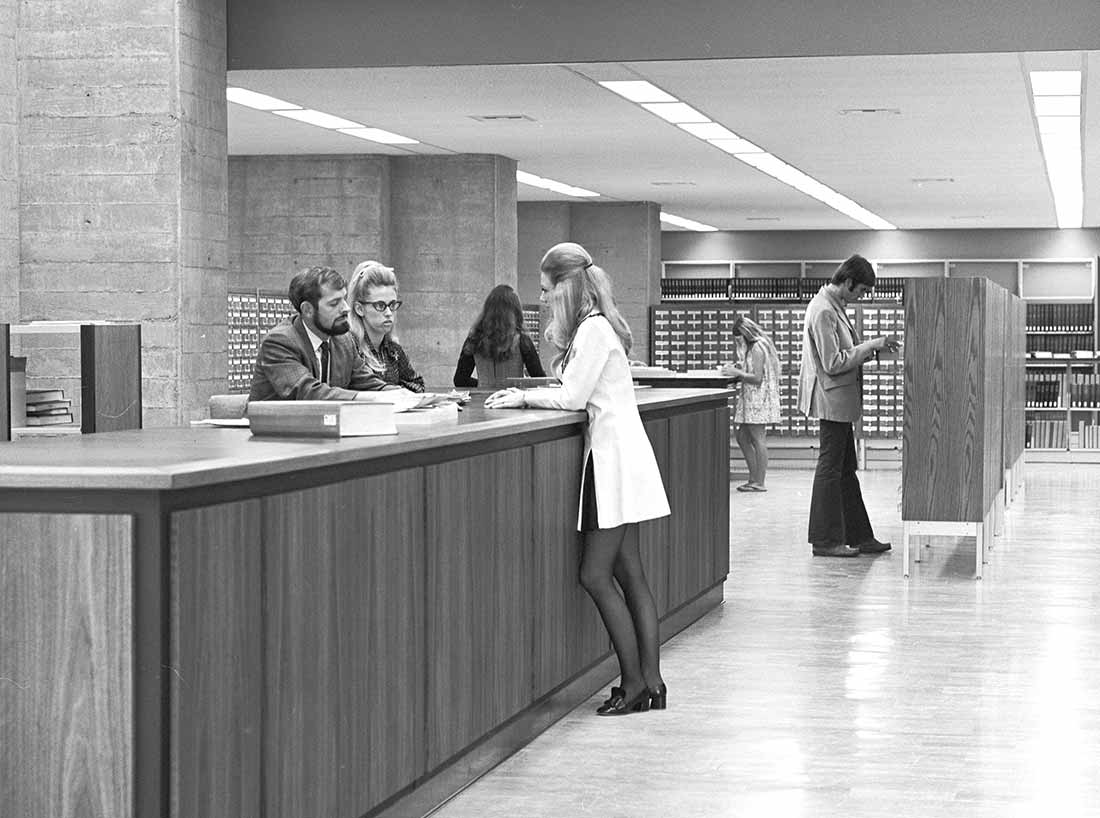
The circulation desk and card catalog at the UC San Diego Central University Library, December 4, 1970. Photo courtesy of Scripps Institution of Oceanography Photographs, Special Collections & Archives, UC San Diego Library.
Summer had come to a close and fall quarter was quickly approaching. Students were beginning to arrive on campus while faculty feverishly put finishing touches on their syllabi. All was pretty much following the normal routine except for one very special occasion: the grand opening of the campus’ newest architectural masterpiece, the iconic Geisel Library building, then known as the Central University Library.
The Triton community had been teeming with excitement during the construction of the building, which spanned from 1968 to 1970, making the grand opening a much-anticipated event. In fact, the buzz around the university’s new library was so great it was helping the institution build its reputation as a place of quality education and innovative research.
The first of some 750,000 volumes were moved into the building on June 29, 1970 and on September 29, the doors opened for the very first time. The campus community was finally able to step foot in their brand-new research library and begin to utilize the vast resources within.
Now celebrating its 50th anniversary, Geisel Library is considered by many to be the most recognizable building on campus, and definitely one of the most frequented, welcoming on average more than 2 million visitors per year.
The concept
Let’s rewind even further back in time to the spring of 1964.
UC San Diego’s first chancellor, Herb York, stepped down and soon thereafter John S. Galbraith, who was serving as vice chancellor for academic affairs at the time, was appointed chancellor.
Almost immediately, Galbraith began to lobby for funding to create a “first-rate library” that would place UC San Diego in the upper echelon of University of California (UC) campuses, alongside Berkeley and UCLA. He envisioned a library that would sufficiently nourish the minds of the cross-disciplinary students of tomorrow and align with the young university’s forward-thinking, aspirational goals.
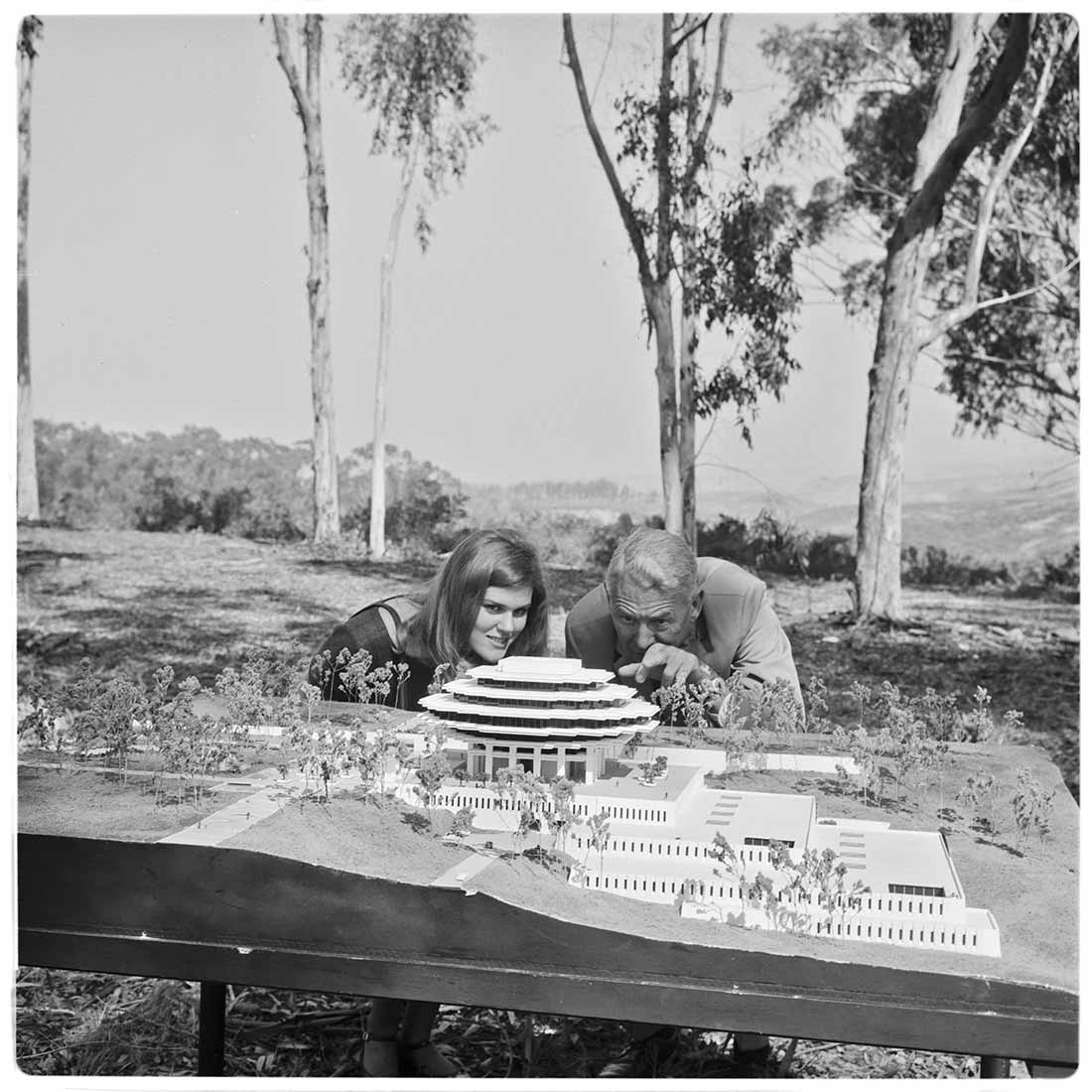
Freshman Valerie Spiess Lipiniski and Chancellor John S. Galbraith studied a model of the soon to be built Central Library at UC San Diego. Image courtesy of Special Collections & Archives, UC San Diego. Photo by Robert Glasheen.
With labored efforts, Galbraith’s wishes were eventually granted and he was given the green light to proceed. He wasted no time. He formed a committee for the project, and in June 1965, he commissioned accomplished architect William L. Pereira to prepare a master plan for UC San Diego’s future focal point, the Central University Library.
“A research library as exceptional as the university itself, that’s what Galbraith set out to achieve, and achieve he did,” said Erik Mitchell, the Audrey Geisel University Librarian. “I am so proud of how our Library serves our UC San Diego community, from the grand space that Geisel provides to the amazing staff, collections and events, all of which have allowed us to secure our place as one of the nation’s top academic research libraries—no easy feat. We also owe it in part to early trailblazers like Galbraith.”
The design
Pereira’s first step in the process was to pinpoint an ideal location for the Library. After conducting an exhaustive study that produced 19 possible sites, he and his staff ultimately recommended a picturesque, wooded area in the center of campus that would allow the Library to remain a visible and symbolic landmark despite future developments.
Next came the design. Pereira combined a number of architectural schemes to develop a design that led to the spherical, otherworldly shape of the building. He wanted to go beyond functionality with his design and produce a library that would “convey to future generations the idea of the power and permanency of the knowledge contained inside it,” as he stated in his original report.
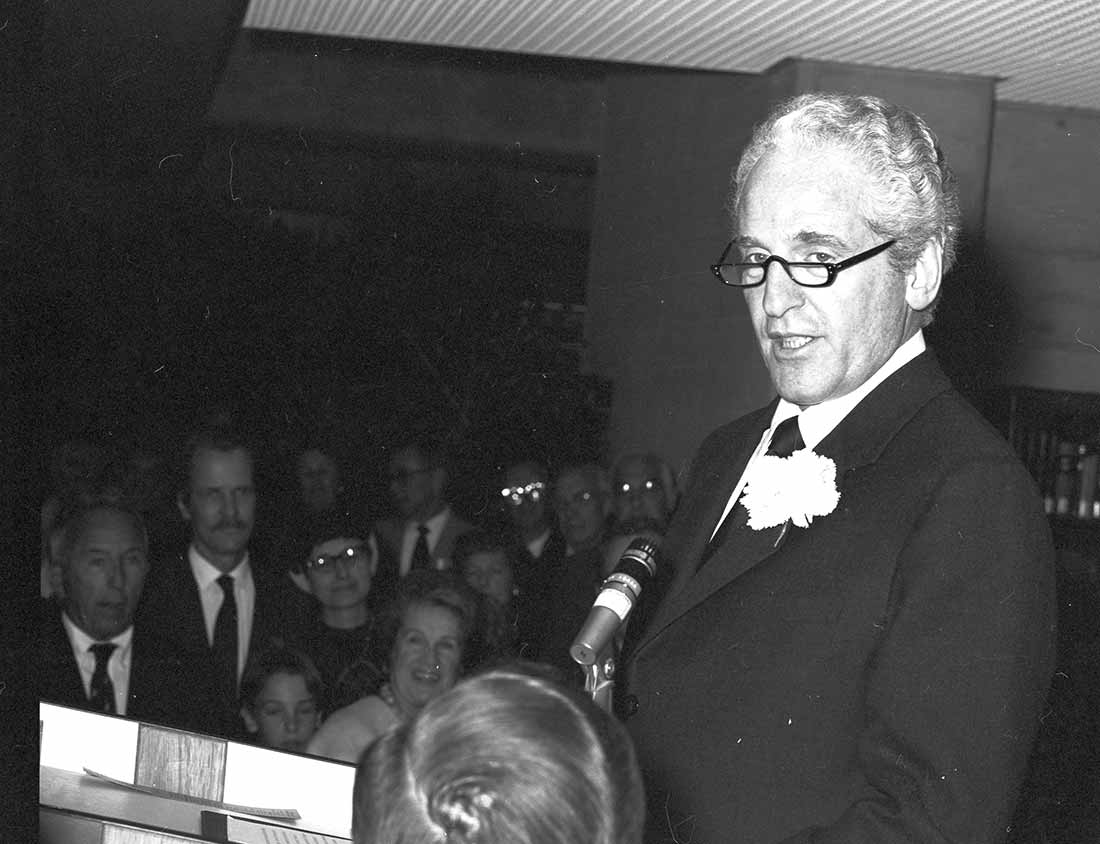
Architect William Pereira. Photo courtesy of Scripps Institution of Oceanography Photographs, Special Collections & Archives, UC San Diego Library.
“Pereira’s work is simply extraordinary, but for some reason as an architect his work is drastically under-celebrated. The man was an expressive genius, way ahead of his time,” said Kevin deFreitas, who is the lead architect for Geisel’s upcoming interior renovation project.
Many are unaware of Pereira’s full body of work, which consists of well over 300 projects, including highly recognizable buildings in each of California’s three major cities: San Diego (Geisel Library), San Francisco (Transamerica Pyramid) and Los Angeles (numerous works including the Theme Building at LAX, Los Angeles County Museum of Art and the City of Irvine’s master plan).
Over time, Pereira’s unique Brutalist architectural design became known worldwide, eventually leading to the university using the building’s silhouette as its official logo—an early demonstration of how much influence architecture can have on an institution’s identity.
“Geisel is what makes architecture special. It excites your imagination and makes you feel something,” deFreitas added. “From a design perspective, the Library is just as powerful today as it was ambitious for an upstart UC campus on the bluffs of La Jolla 50 years ago.”
The construction
Funding for the Central University Library project was received in May 1968 and construction began soon thereafter. The total cost for the project, including architectural design, construction, furniture, equipment and administration was $5.4 million, with $4.4 million being construction costs—just about $25 per square-foot.
Originally designed to be a steel-framed structure, the primary building material for the Library was changed to concrete due to the rising cost of steel in the 1960s. In the end, more than 38,000 square feet of glass and 17,000 cubic yards of concrete were used to complete the Library. The concrete dons a horizontal wood grain left by the wood forms used for casting.
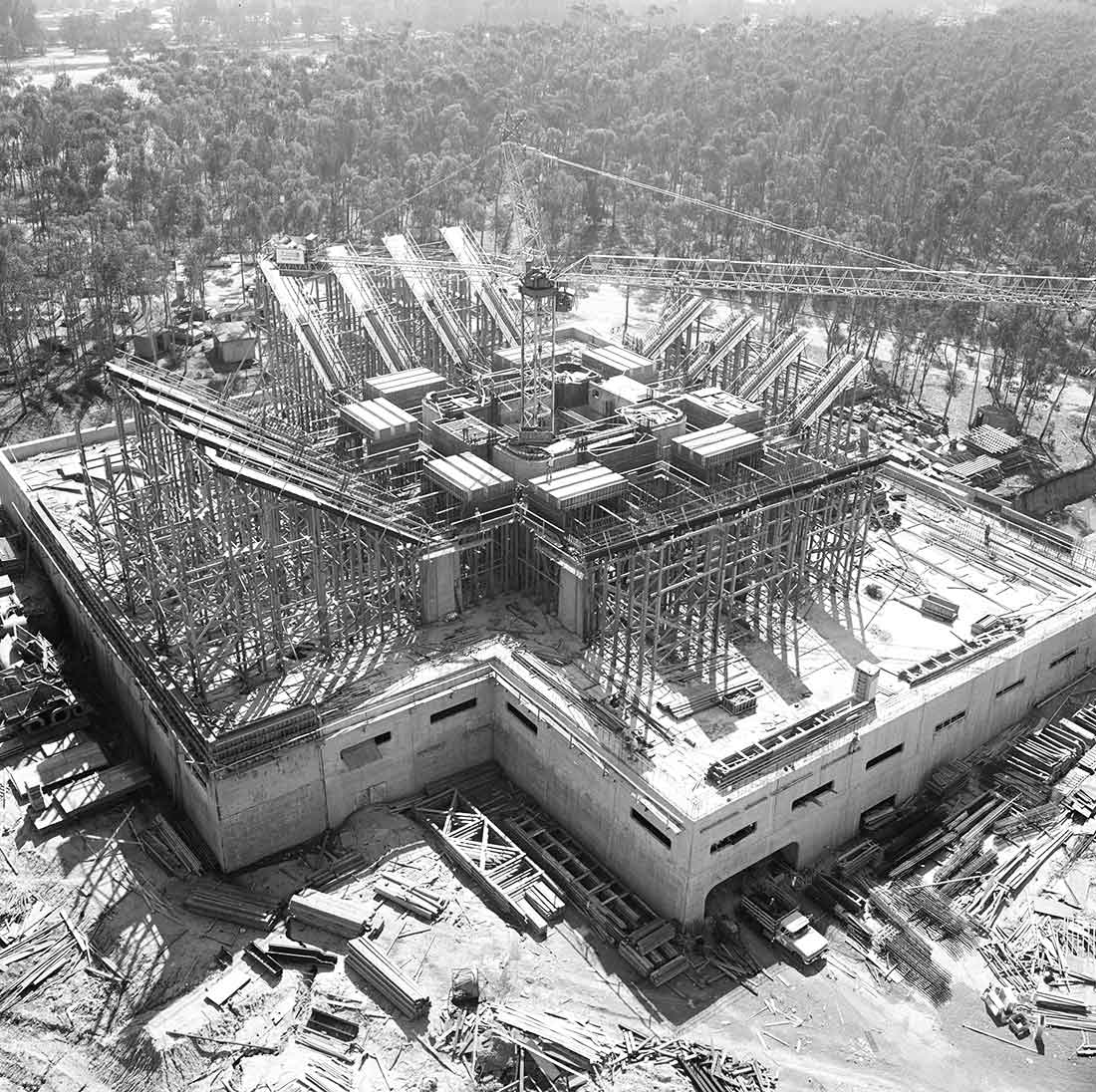
Aerial view of the construction of the UC San Diego Central University Library, March 28, 1969. Photo courtesy of Scripps Institution of Oceanography Photographs, Special Collections & Archives, UC San Diego Library.
To bear the weight and stress of the cantilevered building, four angled cast-in-place columns (or “bents”) are anchored in footings on all sides of the building, each containing 1,500 cubic yards of concrete. The bents angle upward at 45 degrees to the sixth level and are tied to their counterpart across the building (at both the fifth and sixth levels) by approximately 300 high-tensile steel post-tensioning rods, each 1/4 inch in diameter.
A faculty member at the dedication ceremony recalled Pereira waxing poetic about the structure, stating that in order to experience the building properly visitors should “lean back against the foundation and look up along one of the diagonal concrete columns, and project yourself into the sky of knowledge!”
Now, let’s fast-forward to the 1990s.
With a growing student population and increased visitorship, the need for more public space became impossible to ignore. Thankfully, Pereira’s original design allowed for the possibility for expansion in the future, and in 1992, an underground addition on the east, west and south sides of the building was designed by Latvian-American architect Gunnar Birkerts. Birkerts deliberately designed this addition to extend the foundation of the strong, geometrical form of the existing structure while using glass and natural light to situate the Library into the landscape.
After the expansion was complete, the building was renamed University Library at the rededication ceremony in 1993. On December 1, 1995, it was renamed Geisel Library in honor of Audrey S. and Theodor Seuss Geisel (better known as Dr. Seuss) in recognition of Audrey’s generosity toward the Library.
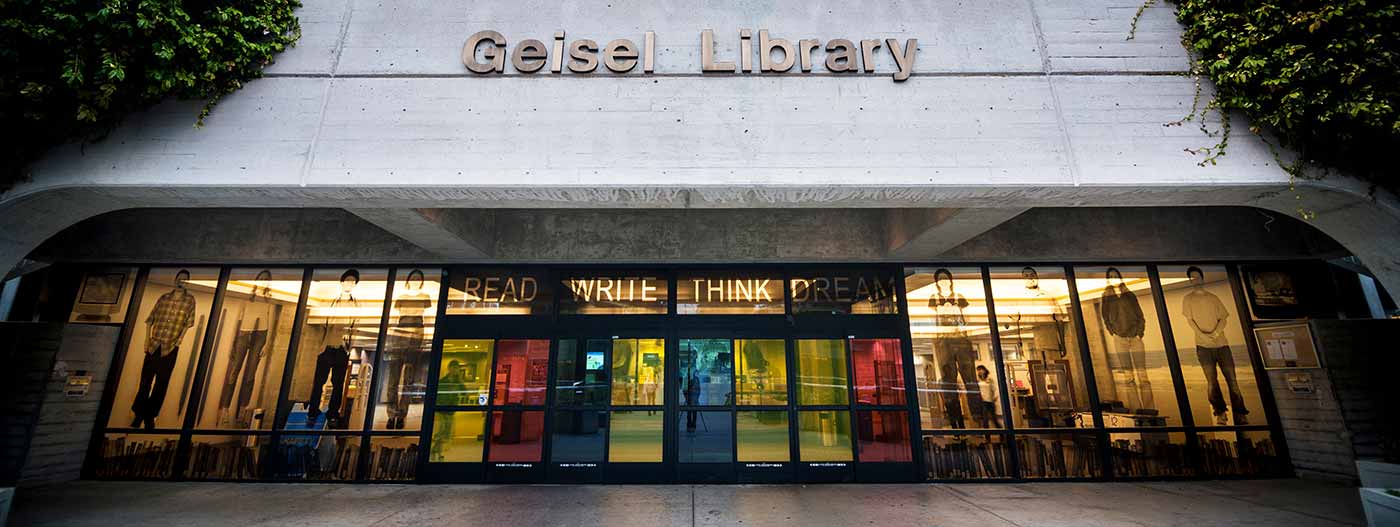
In 1995, the University Library was renamed Geisel Library in honor of the contributions of Theodor Seuss Geisel ("Dr. Seuss") and his wife Audrey, following a $20 million gift from Audrey Geisel. The Mandeville Special Collections Library within is the primary repository for original Dr. Seuss materials, containing more than 20,000 original works and rare memorabilia. Photo by Erik Erik Jepsen.
The present
Today, approximately 1.4 million print volumes call Geisel Library home, and the UC San Diego Library system as a whole provides access to more than 7 million digital and print volumes, journals and multimedia materials. Geisel is also home to rare and unique primary works in its Special Collections & Archives, including the Hill Collection of Pacific Voyages, Southworth Spanish Civil War Collection, Archive for New Poetry and many more.
“We aim to preserve history for the future in support of the university's academic programs,” said Lynda Claassen, longtime director of Special Collections & Archives at the Library. “Our goal is to organize information, then share it in meaningful and efficient ways with various communities.”
Over the years, the Library has made it a point to keep pace with technological advances in library science, integrating cutting-edge offerings to meet the diverse needs of undergraduates, graduate students and postdoctoral researchers. Geisel Library, in particular, provides campus constituents with free access to the Digital Media Lab, which contains 3D printers and virtual reality headsets, and the Data & GIS Lab, where librarians provide guidance on quantitative, qualitative and geographical research.
Geisel is also widely viewed as a place of community. Library employees work diligently to put on events that allow campus and community members to engage with one another, oftentimes leading to creative partnerships and thoughtful dialogue. To refuel and decompress, patrons can also enjoy a cup of coffee at Audrey’s Café and explore rotating exhibits showcasing historic and rarely seen works from the Library’s Special Collections & Archives.
The future
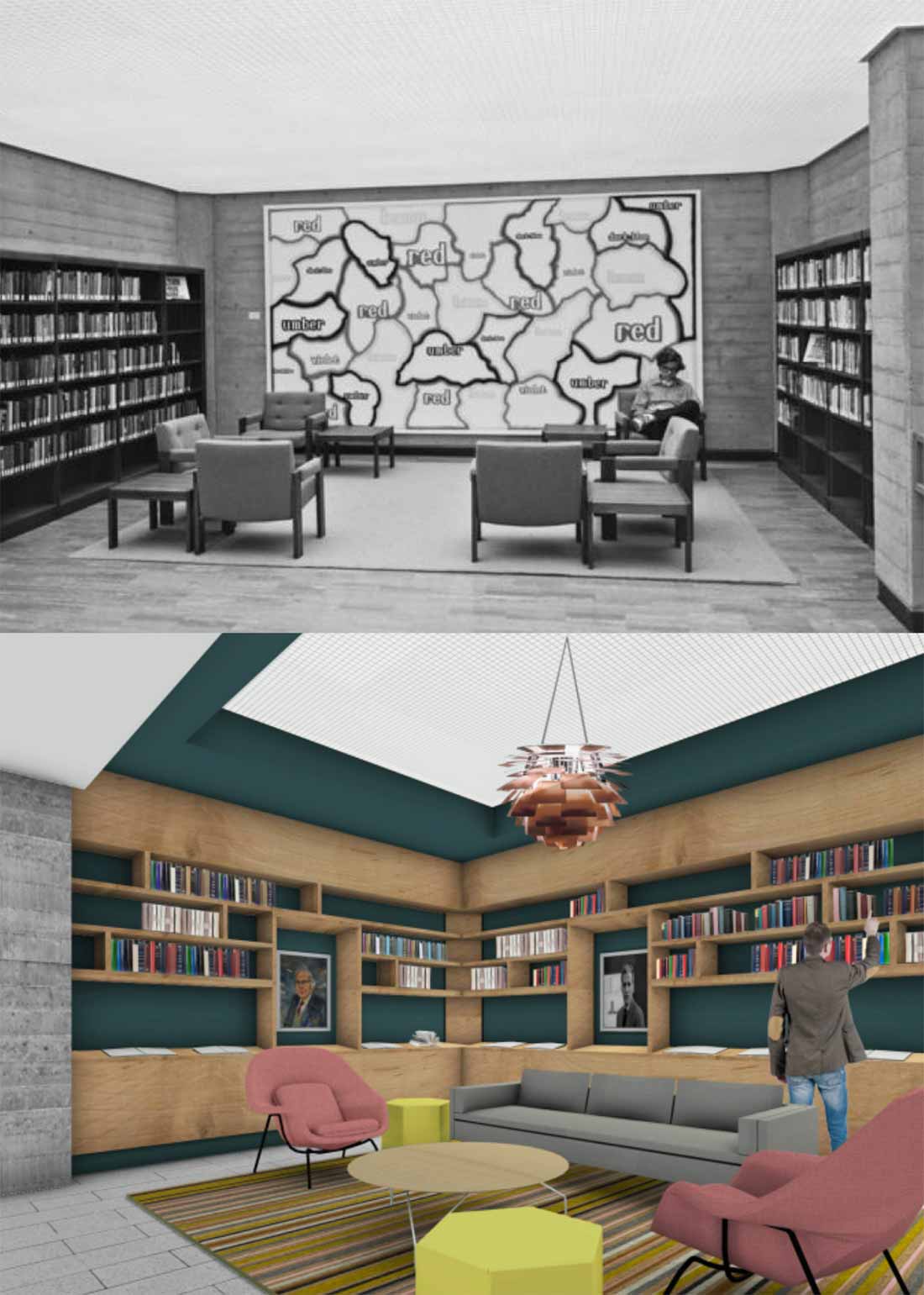
An original photo and future draft rendering of the “meet spot” at Geisel Library. Photo courtesy of the UC San Diego Library and Kevin deFreitas Architects.
Looking ahead, there is still so much great work to do. The UC San Diego Library seeks to modernize Geisel’s interior spaces, integrating even more technology to meet the evolving needs of Library users.
The upcoming renovation, scheduled for completion in 2021, will include updates to the Library’s most heavily-used second (main) floor. The goal is to transform the learning and research experience at Geisel Library by providing updated, cohesive services and creating new spaces for students and faculty to learn, collaborate and showcase their work.
Through this project, deFreitas aims to hearken back to many of Pereira’s original design elements, including bringing back the reading room that was just inside the main entrance in the 1970s. This space will take on a mid-century modern design aesthetic and serve as a “meet spot” for visitors, allowing them to pause and decide where within the Library they would like to go.
“Geisel Library means so much to our students and community,” Mitchell added. “If you visit the Library in the spring and summer months, you’ll likely see students posing outside on the forum for their graduation photos. This speaks to their affinity for the building and, I hope, to the positive experiences they had in the Library. I am excited for the Library’s future at the center of this great university.”
The Library has planned a yearlong celebration in honor of Geisel’s bold legacy. Festivities include signature events featuring acclaimed American authors, esteemed architects and other notable speakers.
The celebration officially kicks off on Wednesday, September 16 at 5:30 p.m. with the first signature event, A Conversation with Tara Westover. View registration details, information on the newly created UC San Diego Library Associates Giving Society and more.
UC San Diego affiliates and the public are also encouraged to share their favorite memories at Geisel Library on social media using #Geisel50 or via this form.
Share This:
You May Also Like
Stay in the Know
Keep up with all the latest from UC San Diego. Subscribe to the newsletter today.


